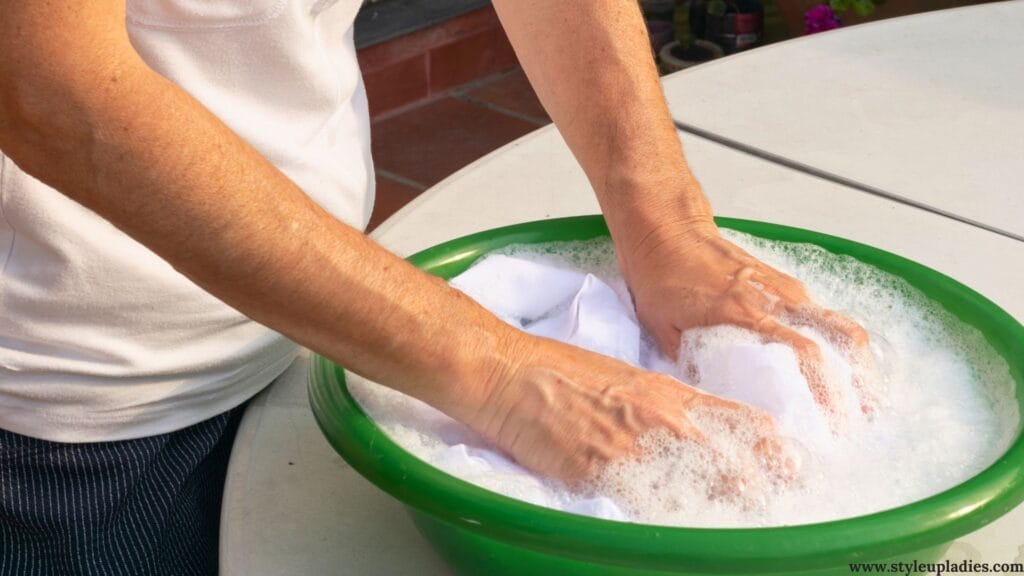Have you ever pulled your favorite t-shirt out of the dryer only to find it’s now child-sized? Or maybe you purposely bought a shirt a size too big, hoping it would shrink.
Either way, you’ve got a shirt that’s too snug or way too baggy. Can that over-shrunken shirt be stretched back out? Or can that way-too-big shirt be downsized?
Whether you’ve got a top that’s a bit too loose or you’re looking to get that perfect fitted look, I’ve got you covered with some easy tips and tricks.
Table of Contents
How to Shrink a Shirt – Introduction
First off, let me just say that accidentally shrinking your favorite shirt in the wash is a total bummer. But sometimes, a little strategic shrinkage can be a good thing! If you’ve got a shirt that’s a size or two too big, or you’re going for that trendy fitted look, intentionally shrinking your shirt can be a game-changer.
But before we get into the nitty-gritty of how to shrink a shirt, let’s talk about what types of fabrics are best for shrinking. Natural fibers like cotton, wool, and linen are generally easier to shrink than synthetic fabrics like polyester and nylon. That’s because natural fibers are more prone to relaxing and contracting when exposed to heat and moisture.
How to Shrink a Shirt?
Alright, let’s get down to business. Here are three foolproof ways to shrink your shirt:
1. Hot Water Wash and Dry
This is probably the easiest and most common method for shrinking a shirt. Here’s what you do:
- Check the care label to make sure your shirt is made of a fabric that can handle high heat, like cotton or wool.
- Turn your shirt inside out to protect any graphics or prints.
- Throw your shirt in the washing machine and set it to the hottest water setting.
- Once the wash cycle is done, toss your shirt in the dryer and set it to high heat.
- Check your shirt periodically to see if it’s reached your desired size. If not, run it through another hot wash and dry cycle.

2. Boiling Water Method
If you’re looking for a more targeted approach to shrinking your shirt, the boiling water method might be for you. Here’s how it works:
- Fill a large pot with water and bring it to a boil.
- Once the water is boiling, turn off the heat and carefully submerge your shirt in the water.
- Let your shirt soak for about 5 minutes, then use a pair of tongs to remove it from the water.
- Wring out the excess water and lay your shirt flat to dry.
- Once it’s dry, try it on to see if it’s shrunk to your liking. If not, repeat the process.

3. Iron Method
If you only need to shrink certain areas of your shirt, like the sleeves or the waistband, the iron method is a great option. Here’s what you do:
- Wet the areas of your shirt that you want to shrink with hot water.
- Set your iron to the highest heat setting that’s safe for your shirt’s fabric.
- Iron the damp areas of your shirt, applying firm pressure and holding the iron in place for a few seconds at a time.
- Repeat until you’ve achieved your desired level of shrinkage.

What Types of Fabrics Shrink Easily?
As I mentioned earlier, natural fibers tend to shrink more easily than synthetic ones. Here are some of the most shrinkable fabrics:
- Cotton: Cotton is one of the easiest fabrics to shrink, which is why so many people accidentally shrink their cotton shirts in the wash. But if you’re intentionally trying to shrink a cotton shirt, you’re in luck!
- Wool: Wool is another natural fiber that’s prone to shrinking, especially when exposed to heat and moisture. Just be careful not to overdo it, as wool can become misshapen or felted if it’s shrunk too much.
- Linen: Linen is a lightweight, breathable fabric that’s perfect for summer. It’s also relatively easy to shrink, although it may not shrink as much as cotton or wool.
- Rayon: Rayon is a semi-synthetic fabric that’s made from natural fibers like wood pulp or bamboo. It has a silky, flowy texture that’s similar to cotton, and it can shrink quite a bit when exposed to heat.
On the other hand, synthetic fabrics like polyester, nylon, and acrylic are much more resistant to shrinking. That’s because they’re made from plastic fibers that don’t relax or contract as easily as natural fibers.
If you’re trying to shrink a shirt made from one of these fabrics, you may need to use a more aggressive method like boiling water or ironing.

How Much Can a Shirt Shrink?
The amount that a shirt can shrink depends on a few different factors, including the type of fabric, the quality of the fabric, and the method you use to shrink it.
In general, you can expect a cotton shirt to shrink by about 3-5% in both length and width. So if you have a shirt that’s 20 inches long, it may shrink by about an inch after a hot wash and dry cycle.
Wool and linen shirts may shrink a bit more, especially if they’re not pre-shrunk. You can expect these fabrics to shrink by about 5-8% in both length and width.
Synthetic fabrics like polyester and nylon may only shrink by about 1-3%, if at all. And some synthetic fabrics, like spandex, may actually stretch out rather than shrinking.
It’s important to keep in mind that shrinking a shirt is not an exact science.
Even if you follow all the steps perfectly, there’s no guarantee that your shirt will shrink to the exact size you want. That’s why it’s always a good idea to start with a shirt that’s only slightly too big, rather than trying to shrink a shirt that’s several sizes too large.
How to Unshrink a Shirt?
Okay, so let’s say you’ve accidentally shrunk your favorite shirt in the wash. Is there any way to unshrink it? The short answer is: maybe.
If your shirt is made of a natural fiber like cotton or wool, you may be able to stretch it back out to its original size. Here’s what you can try:
- Fill a sink or basin with lukewarm water and add a capful of baby shampoo or hair conditioner.
- Submerge your shrunken shirt in the water and let it soak for about 15 minutes.
- Gently stretch the shirt in all directions, being careful not to tear or damage the fabric.
- Rinse the shirt in cold water to remove any remaining shampoo or conditioner.
- Lay the shirt flat on a towel and roll it up to remove excess water.
- Stretch the shirt back out to its original shape and size, then lay it flat to dry.
Keep in mind that this method may not work for all fabrics, and it may not restore your shirt to its exact original size. But it’s worth a try if you’ve accidentally shrunk a shirt that you really love.

Can I shrink a shirt with vinegar?
I’ve seen some people recommend using vinegar to shrink a shirt, but to be honest, I’m not sure how effective this method really is.
The idea behind using vinegar is that the acetic acid in the vinegar can help relax the fibers in the fabric, making them more prone to shrinking. Some people recommend adding a cup of white vinegar to the washing machine along with your shirt and running it through a hot wash cycle.
However, I haven’t seen any scientific evidence to support this method, and I worry that the vinegar could potentially damage or discolor some fabrics. Plus, your shirt is going to come out smelling like vinegar, which isn’t exactly the most pleasant scent.
If you’re set on trying the vinegar method, I’d recommend doing a small patch test first to make sure it doesn’t harm your shirt. But personally, I think you’re better off sticking with the tried-and-true methods of hot water washing, boiling, or ironing.
Can I shrink an XL down to a medium?
This is a question I get a lot, and unfortunately, the answer is usually no. While it is possible to shrink a shirt by a size or two, going from an XL to a medium is a pretty big jump.
Most shirts will only shrink by about 3-5% in both length and width, which is usually enough to go down one size at most. So if you have an XL shirt that’s 25 inches long and 20 inches wide, it may shrink down to about 24 inches long and 19 inches wide after a hot wash and dry cycle. That’s still going to be closer to a large than a medium.
If you’re really set on shrinking an XL shirt down to a medium, you may need to get creative. One option is to try the boiling water method and let the shirt soak for a longer period of time, like 10-15 minutes. You can also try running it through multiple hot wash and dry cycles until it reaches your desired size.
However, keep in mind that the more you shrink a shirt, the more likely it is to become misshapen or damaged. The fibers in the fabric can only take so much heat and agitation before they start to break down, which can lead to holes, tears, or a generally worn-out appearance.
If you’re really in need of a medium-sized shirt, your best bet is probably to just buy one that fits you properly. Trust me, it’s a lot less hassle than trying to shrink an XL down to size!
Can I Shrink a Cotton Shirt in the Wash Dryer?
Yes, you can often shrink a cotton shirt by washing and drying it with heat. Cotton is a natural fiber that is sensitive to high temperatures.
To try to shrink a cotton shirt:
- Wash the shirt by itself in the hottest water possible. This will help relax the cotton fibers.
- Put the shirt in the dryer on the highest heat setting (usually the regular setting, not the delicate cycle which uses lower heat). Leave it in for a full drying cycle.
- When it’s done, the shirt will likely have shrunk one size. Most shirts shrink more in length than in width. If it shrank a lot, try reshaping it gently and laying flat to finish drying.
The hotter the water and drying cycle, and the more frequently this is done, the more a 100% cotton shirt will shrink. Shrinkage mostly occurs in the length because that’s the “with-the-grain” direction of the fabric, due to which the threads are tighter than the width. The weave can also affect shrinkage.

Can I Shrink a Polyester Shirt?
Polyester is a synthetic fabric that’s known for its durability and resistance to shrinking. Unlike natural fibers like cotton and wool, polyester is made from plastic fibers that don’t respond as readily to heat and moisture.
That being said, it is still possible to shrink a polyester shirt, but it may take a bit more effort than shrinking a cotton shirt. Here are a few methods you can try:
- Boiling water method: Fill a large pot with water and bring it to a boil. Turn off the heat and carefully submerge your polyester shirt in the water. Let it soak for about 5-10 minutes, then remove it from the water and wring out the excess moisture. Lay the shirt flat to dry, and it should have shrunk a bit.
- Ironing method: Set your iron to the highest heat setting that’s safe for polyester (usually around 300°F). Lay your shirt flat on an ironing board and cover it with a damp cloth. Press the iron down firmly on the damp cloth, holding it in place for about 10-15 seconds at a time. Repeat this process until you’ve covered the entire shirt, then let it cool and dry completely.
- Dryer method: Wash your polyester shirt in hot water, then toss it in the dryer on the highest heat setting. Check on it every 10-15 minutes to see if it’s reached your desired size. Keep in mind that this method may not work as well as the others, as polyester is more heat-resistant than natural fibers.
It’s important to note that shrinking a polyester shirt may affect its texture and appearance. The high heat can cause the fibers to melt or become stiff, which can make the shirt feel rough or uncomfortable to wear.
If you do decide to shrink a polyester shirt, be sure to do so carefully and gradually to avoid damaging the fabric.
What if My Shirt Shrinks Too Much?
It’s a common problem: you try to shrink your shirt just a little bit, but end up with a top that’s way too small. What can you do?
First of all, don’t panic. Depending on the fabric and the method you used to shrink your shirt, you may be able to stretch it back out to its original size. Here are a few things you can try:
- Soak the shirt in lukewarm water mixed with a bit of baby shampoo or hair conditioner. This will help relax the fibers and make them more pliable.
- Gently stretch the shirt in all directions while it’s still damp. Focus on the areas that feel particularly tight or constricted.
- Lay the shirt flat on a towel and roll it up to remove excess water. Then, stretch it out again and lay it flat to dry.
- If the shirt is still too small, you can try putting it on while it’s damp and stretching it out with your body. Move around in the shirt, stretching your arms and torso to help loosen up the fibers.
- If all else fails, consider taking the shirt to a professional tailor. They may be able to let out the seams or add some extra fabric to make the shirt wearable again.
Of course, the best way to avoid shrinking a shirt too much is to take it slow and be careful. Start with a gentle method like soaking the shirt in hot water, and only move on to more aggressive techniques if necessary. And always keep an eye on the shirt as it’s shrinking, so you can stop the process before it goes too far.
With a little patience and care, you should be able to shrink your shirt to the perfect size without any major mishaps. And if worst comes to worst, just remember: it’s only a shirt. There are plenty more where that came from!

Conclusion
Well, there you have it, folks! Everything you ever wanted to know about how to shrink a shirt. Whether you’re looking to downsize a too-big top or just achieve that perfect fitted look, these tips and tricks should help you get the job done.
Just remember to always check the care label first, start with a gentle method like hot water washing, and don’t be afraid to experiment a little to find what works best for your shirt. And if all else fails, you can always take it to a professional tailor for a custom fit.
I hope this guide has been helpful, and as always, feel free to reach out if you have any other fashion-related questions. Until next time, stay stylish!
FAQs
Can I shrink a shirt that’s already been washed and dried?
Yes, you can still shrink a shirt that’s already been washed and dried. Just follow the same methods of hot water washing, boiling, or ironing.
Will shrinking a shirt damage the fabric?
It depends on the fabric and how much you shrink it. Natural fibers like cotton and wool can usually handle a bit of shrinking without too much damage, but synthetic fabrics may become misshapen or worn out if you shrink them too much.
Can I shrink a shirt with a logo or graphic on it?
Yes, but be careful. High heat can sometimes cause graphics or logos to crack, peel, or fade. If you’re worried about damaging the graphic, try a gentler method like soaking the shirt in hot water rather than running it through the dryer.
How long does it take to shrink a shirt?
It depends on the method you use. A hot wash and dry cycle will usually shrink a shirt in about an hour, while the boiling water method may only take a few minutes. Ironing may take a bit longer, especially if you’re trying to shrink a larger area.
Can I shrink a shirt that’s too long?
Yes, you can shrink a shirt that’s too long. Just focus on shrinking the length rather than the width. You can try ironing the bottom hem or soaking just the bottom part of the shirt in hot water.
Is it better to shrink a shirt before or after washing it?
It’s generally better to shrink a shirt before washing it, as this will help set the new size and prevent further shrinkage in the future. However, if you’ve already washed your shirt and it’s still too big, you can still try shrinking it using one of the methods outlined above.








Leave a Reply